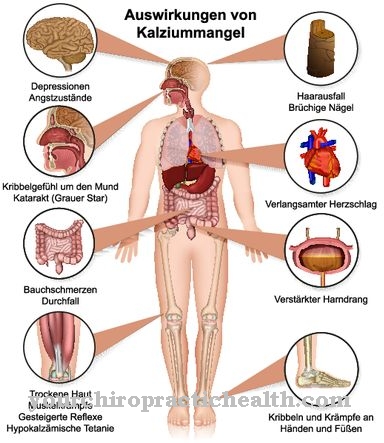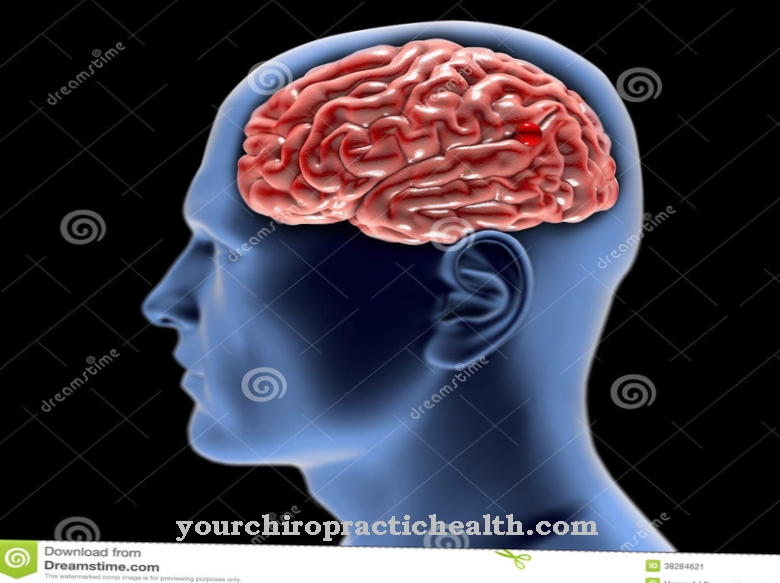Under a Root compression syndrome In human medicine, irritation of the nerve roots in the area around the spine is understood. Such irritation is usually due to mechanical causes (e.g. pressure) and leads to considerable back pain, which can also radiate. In rare cases, the root compression syndrome can also be congenital.
What is root compression syndrome?
Of a Root compression syndrome This is spoken in medicine when the roots of the spinal nerves are irritated due to mechanical causes (e.g. sustained pressure). Spinal nerves are all nerves that arise directly from the spinal cord.
In the specialist literature, a distinction is made between different forms of root compression syndromes. A classification can be made both according to the time of origin and the localization of the stimulus. In the latter case, a distinction is made between cervical, thoracic and lumbar syndrome.
The cervical syndrome is directed towards the neck. The thoracic syndrome belongs to the area of the chest arm (thorax). Finally, there is lumbar syndrome in the lumbar area. Lumbar syndrome is the most common form of root compression syndrome because it usually puts the most stress on the lumbar vertebrae.
Sciatica are special forms. Based on the point in time at which it develops, the literature also differentiates between congenital and acquired root compression syndrome.
causes
Root compression syndrome can either be caused by external factors or be congenital. However, the congenital form is rare. It is caused by deformations of the spine, such as those that can occur in the context of scoliosis.
Acquired root compression syndromes have a variety of causes. Fractures of the spine, tumors in the area of the spine, hematomas and various infections should be considered. However, the majority of diseases can be traced back to degenerative factors.
The underlying cause is increased wear and tear, which leads to a reduction in functionality. The progressive wear and tear leads to pathological changes in the bone tissue. The soft tissues surrounding the area around the nerve roots can also be changed. These changes are then triggered by osteoarthritis of the facet joints (facet syndrome), osteophytes or a herniated disc (disc prolapse).
Symptoms, ailments & signs
Root compression syndrome causes particularly severe pain in the back area. The center of pain varies depending on the type of syndrome. For example, in patients suffering from a lumbar form of the syndrome, an intensification in the lumbar area can occur.
Analogously to this, a center can lie in the rear area of the thorax or the lower neck area. However, this is not mandatory. Since the nerves are irritated or pinched, the nerves may also lose sensitivity. This manifests itself in a loss of feeling.
Various paresthesias can also develop around the supply area of the affected nerves. Paresthesia is a body sensation that is not triggered by adequate stimuli. It usually manifests itself as an uncomfortable tingling sensation, cold, warmth or numbness.
In the case of particularly severe manifestations, paralysis often occurs. It is characteristic of the pain of a root compression syndrome that it radiates. Pain or discomfort in the area of the hips or legs are also nothing unusual.
Some people also report dysfunction of the bladder and rectum. However, the exact form or intensity of the radiation depends on the individual case.
Diagnosis & course of disease
The diagnosis of root compression syndrome can only be made by a doctor. This will first localize the pain. He will also try to categorize the intensity, duration and type of pain by interviewing the patient.
This can provide an opportunity to initiate further diagnostic measures. A reliable diagnosis cannot be made without technical aids. X-rays are usually taken at the beginning to rule out any fractures or tumors. An exact representation of the nerves can only be achieved with magnetic resonance imaging (MRT) or computed tomography (CT).
Myelo CT may also be considered. Sometimes functional myelography is also used. A broad spectrum of measures is therefore available for diagnosing root compression syndrome.
When should you go to the doctor?
If the person concerned suffers from persistent or increasing pain in the back, a doctor should be visited. If the possibilities of movement are impaired and, in particular, the rotational movements in the area of the back are restricted, medical examinations are necessary to clarify the cause. Sensitivity disorders, pressure sensitivity or muscular complaints should be examined as these are warning signals from the organism.
If you are hypersensitive to cold, heat or other perceptual stimuli, the observations should be discussed with a doctor. If the physical performance drops and sporting or professional activities can no longer be carried out, a medical examination is required. Consultation with a doctor is also necessary in the event of impairments in coping with everyday life. If there are behavioral problems, mood swings or other emotional peculiarities, the cause should be investigated.
A decrease in the zest for life, a general malaise and a withdrawal from social life are considered worrying. In many cases there are physical irregularities that should be examined more closely by a doctor. If the complaints move from the back to the hips or legs, action is required. A tingling sensation in the back, bottom, or thighs should be discussed with a doctor. If the bladder malfunctions, a doctor should be consulted immediately.
Treatment & Therapy
The therapy of a root compression syndrome consists of general and special measures. Usually the implementation of the general measures begins. The more specific forms are only used if previous attempts at therapy were unsuccessful.
The general therapies include surgical measures (e.g. decompression), physiotherapy, acupuncture and drug-based pain therapy. The scope and type of pain therapy depend on the frequency and intensity of the pain.
If these are acute or set in suddenly, peripheral preparations are administered. These are those that work directly at the point where the pain arises. These include anti-inflammatory drugs (for example parecoxib or etoricoxib). Muscle relaxants are also administered as a supplement. These are substances that relax the muscles.
Baclofen (e.g. Lioresal®) is often used. In the case of particularly severe pain, preparations are used that work directly in the brain and prevent the transmission of pain stimuli there. Opioids (e.g. tramadol or tilidine) are also prescribed. In these cases, however, there is a risk of addiction. The special therapeutic measures include advanced treatment concepts from pain clinics.
You can find your medication here
➔ Medicines for back painprevention
Strengthened back muscles are suitable for prevention. In addition, activities that can lead to wear and tear in the area of the spine should be reduced.
Aftercare
In the case of root compression syndrome, the options and measures of direct follow-up care are in most cases significantly limited. Therefore, those affected should ideally consult a doctor at an early stage and also initiate treatment in order to prevent the occurrence of other complaints and complications. Often no independent healing can occur, so that those affected are always dependent on treatment by a doctor.
It is advisable to consult a doctor at the first signs. In most cases, root compression syndrome can be relieved well with the help of physical therapy or physical therapy. The person concerned can also do many of the exercises in their own home to prevent other complaints from occurring and to accelerate healing.
In some cases, this disease also requires taking medication. Those affected should pay attention to the prescribed dosage and regular intake to alleviate the symptoms. A doctor should be consulted if anything is unclear or if there are severe side effects. The syndrome usually does not reduce the life expectancy of those affected.
You can do that yourself
This painful disease must be treated by a doctor. Depending on the type of complaint, the family doctor will coordinate the various therapeutic approaches such as pain therapy, acupuncture, physiotherapy or surgery. The patient would do well to follow the advice of the doctor and to take the medication regularly (“compliance”). This is especially true if the root compression syndrome is based on a disease such as a tumor.
If the complaints limit the patient's quality of life so much that he withdraws, then psychotherapeutic crisis intervention is indicated. In order to support the body's own immune system and thus to ensure a better general condition, the patient is advised to lead a healthy lifestyle. First and foremost, this includes avoiding stimulants such as nicotine and alcohol, because they unnecessarily weaken the body. A diet rich in vitamins and fiber, on the other hand, rebuilds the body. In addition, the patient should exercise as much as possible, for example regularly walking, swimming or cycling. Adequate rest is also important.
The patient can also do a lot for better pain management. Learning and using relaxation techniques, for example, can take the pain away from the pain in acute cases. Relaxation techniques can be breathing or meditation exercises as taught in yoga, or progressive muscle relaxation according to Jacobson.


.jpg)














.jpg)







.jpg)


